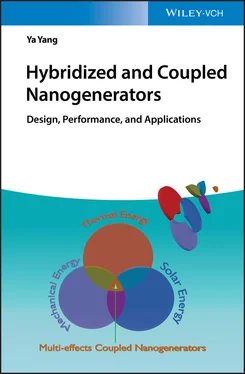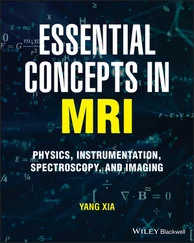Ya Yang - Hybridized and Coupled Nanogenerators
Здесь есть возможность читать онлайн «Ya Yang - Hybridized and Coupled Nanogenerators» — ознакомительный отрывок электронной книги совершенно бесплатно, а после прочтения отрывка купить полную версию. В некоторых случаях можно слушать аудио, скачать через торрент в формате fb2 и присутствует краткое содержание. Жанр: unrecognised, на английском языке. Описание произведения, (предисловие) а так же отзывы посетителей доступны на портале библиотеки ЛибКат.
- Название:Hybridized and Coupled Nanogenerators
- Автор:
- Жанр:
- Год:неизвестен
- ISBN:нет данных
- Рейтинг книги:3 / 5. Голосов: 1
-
Избранное:Добавить в избранное
- Отзывы:
-
Ваша оценка:
- 60
- 1
- 2
- 3
- 4
- 5
Hybridized and Coupled Nanogenerators: краткое содержание, описание и аннотация
Предлагаем к чтению аннотацию, описание, краткое содержание или предисловие (зависит от того, что написал сам автор книги «Hybridized and Coupled Nanogenerators»). Если вы не нашли необходимую информацию о книге — напишите в комментариях, мы постараемся отыскать её.
Hybridized and Coupled Nanogenerators — читать онлайн ознакомительный отрывок
Ниже представлен текст книги, разбитый по страницам. Система сохранения места последней прочитанной страницы, позволяет с удобством читать онлайн бесплатно книгу «Hybridized and Coupled Nanogenerators», без необходимости каждый раз заново искать на чём Вы остановились. Поставьте закладку, и сможете в любой момент перейти на страницу, на которой закончили чтение.
Интервал:
Закладка:
Chapters 8 and 9 (contributors: Yun Ji, Ya Yang) introduce recent advancements of multi‐effects coupled nanogenerators, including photovoltaic–pyroelectric effect nanogenerator, pyro‐piezoelectric effect nanogenerator, tribo‐piezo‐pyro‐photoelectric effect nanogenerator, and so on. The two chapters emphasize the working principle, materials, device configuration, output performance, and application of the multi‐effects coupled nanogenerators. Particularly, pyroelectric effect, photovoltaic effect, thermal effect, piezoelectric effect, triboelectric effect, and interactions among them are described in detail. Multifunctional ferroelectrics and semiconductors are introduced, such as BaTiO 3, BiFeO 3, ZnO, and SnS. State‐of‐the‐art device structure and the relevant output electric signals (output current, voltage, and power) are presented. Applications of the multi‐effects coupled nanogenerators in the area of energy‐storage device charging, photodetection, multifunctional sensing, and image sensing are reviewed.
Chapter 10 (contributor: Ya Yang) elaborates the three new physical effects, which are based on coupled nanogenerators. Pyro‐phototronic effect is based on the three‐way coupling among semiconductor, pyroelectricity, and photoexcitation. The ferro‐pyro‐phototronic effect is based on the three‐way coupling among ferroelectric materials, pyroelectricity, and photoexcitation. The thermo‐phototronic effect is based on the three‐way coupling among semiconductor, thermoelectricity, and photoexcitation.
The objective of writing this book is to systematically introduce hybridized and coupled nanogenerators. Understanding of the fundamental mechanism and related technological applications of the hybridized and coupled nanogenerators can be seen in this book. The potential readership includes scientists, engineers, undergraduate and graduate students in materials, physics, energy, nano‐science, and other related fields from science and industry.
First, I would like to thank my postdoctoral supervisor (Prof. Zhong Lin Wang) and doctoral supervisor (Prof. Yue Zhang) for good guidance and strong support in these years. It would not have been possible to achieve this research without their guidance and support. Second, I would like to thank my students for their contributions to this book: my postdoctoral student (Yang Wang), and my doctoral students (Kai Song, Bangsen Ouyang, Ding Zhang, Yun Ji). Third, I would like to thank my current and former group members who have made outstanding contributions to the development of hybridized and coupled nanogenerators: Yingchun Wu, Shuhua Wang, Kewei Zhang, Xiandai Zhong, Xue Wang, Ting Quan, Kun Zhao, Qingbin Zhai, Xi Liu, Yang Wang, Jia Qi, Nan Ma, Yun Ji, Bangsen Ouyang, Kai Song, Tiantian Gao, Qiang Jiang, Bo Chen, Yuanming Wang, Yuting Jiang, Ding Zhang, Rudai Zhao, Xue Zhao, Weiqi Qian. Moreover, I thank my family members for the support and understanding. Finally, I want to acknowledge funding by the Beijing Institute of Nanoenergy and Nanosystems, Chinese Academy of Sciences, the National Natural Science Foundation of China (Grant No. 51472055, Grant No. 61404034), External Cooperation Program of BIC, Chinese Academy of Sciences (Grant No. 121411KYS820150028), the 2015 Annual Beijing Talents Fund (Grant No. 2015000021223ZK32), the Beijing Natural Science Foundation (Grant No. 2154059), the University of Chinese Academy of Sciences (Grant No. Y8540XX2D2), the National Key R&D Program of China (Grant No. 2016YFA0202701), and Qingdao National Laboratory for Marine Science and Technology (Grant No.2017ASKJ01).

Ya Yang, Professor
Beijing Institute of Nanoenergy and Nanosystems,
Chinese Academy of Sciences
School of Nanoscience and Technology,
University of Chinese Academy of Sciences
*E‐mail: yayang@binn.cas.cn
Website: http://www.researcherid.com/rid/A-7219-2016
Beijing, China
20 January 2020
1 Overview
1.1 Introduction
Nanogenerators are based on the use of the displacement current of Maxwell as the driving force to convert environmental energies into electric signals, exhibiting various potential applications in wearable electronics, sensor systems, robotics, and other energy‐related science. Prof. Z. L. Wang and coworkers invented the first piezoelectric nanogenerator in 2006 [1], and invented the first triboelectric nanogenerator (TENG) in 2012 [2]. Both these nanogenerators are based on the polarization P sproduced due to the mechanical motions induced electrostatic surface charges, where it is not the electric field produced medium polarization P.
Usually, Maxwell's equations can be expressed by
(1.1) 
(1.2) 
(1.3) 
(1.4) 
where Dis the electric displacement vector ( D= ɛ 0 E+ P). Z. L. Wang added an additional term P sin Din 2017 [3,4]. Thus, Dcan be given as
(1.5) 
where the polarization vector Pis associated with the appearance of the external electric field, while the additional term P sis associated with the appearance of the surface charges that can be independent of external electric fields [5]. Maxwell's displacement current is then expressed as
(1.6) 
where the first term  (electric field induced) is associated with the electromagnetic waves theory, while the
(electric field induced) is associated with the electromagnetic waves theory, while the  added by Wang (called Wang term) is due to the non‐electric field‐induced, strain‐related polarization; this is the practical application of Maxwell's equations in the energies scavenging field as nanogenerators [5].
added by Wang (called Wang term) is due to the non‐electric field‐induced, strain‐related polarization; this is the practical application of Maxwell's equations in the energies scavenging field as nanogenerators [5].
Various energies such as thermal, mechanical, chemical, and solar energies exist in the living environment. However, the occurrence of these energies depends on some working conditions such as weather or some other factors. The purpose of developing hybridized nanogenerators is to scavenge the different energies at the same time by integrating the different energy scavenging units into a system, so that we can obtain stable and sustainable power supply, regardless of whatever energy is available in the environment [6]. Prof. Z. L. Wang and coworkers invented the first hybrid energy cell in 2009 [7]. The first electromagnetic–triboelectric hybridized nanogenerator has been reported to scavenge one vibration energy by two different energy scavenging units in 2015 [8], which can largely enhance the efficiency of conversion from mechanical energy to electric energy. The existing hybridized nanogenerators are based on effectively stacking individual nanogenerators together in parallel or in series, where the individual nanogenerator has independent device structures and output electrodes. This is not suitable for miniaturization of the device dimension and for massive production. It is highly desirable to utilize multifunctional materials to obtain multi‐effects coupled nanogenerators with the same structure, material, and electrodes. By using piezo–tribo–pyro–photoelectric effects, Prof. Ya Yang and coworkers invented the first coupled nanogenerators in 2015 [9], which have the same materials, the same electrodes, and simultaneous different energies scavenging abilities. This book will give a detailed summary about the design, performance, and applications of the hybridized and coupled nanogenerators.
Читать дальшеИнтервал:
Закладка:
Похожие книги на «Hybridized and Coupled Nanogenerators»
Представляем Вашему вниманию похожие книги на «Hybridized and Coupled Nanogenerators» списком для выбора. Мы отобрали схожую по названию и смыслу литературу в надежде предоставить читателям больше вариантов отыскать новые, интересные, ещё непрочитанные произведения.
Обсуждение, отзывы о книге «Hybridized and Coupled Nanogenerators» и просто собственные мнения читателей. Оставьте ваши комментарии, напишите, что Вы думаете о произведении, его смысле или главных героях. Укажите что конкретно понравилось, а что нет, и почему Вы так считаете.












